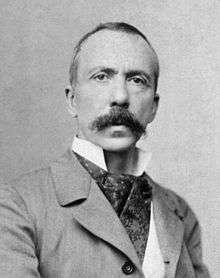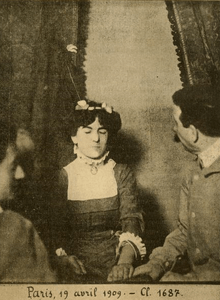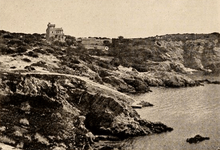Charles Richet
Prof Charles Robert Richet (25 August 1850 – 4 December 1935) was a French physiologist at the Collège de France known for his pioneering work in immunology. In 1913, he won the Nobel Prize in Physiology or Medicine "in recognition of his work on anaphylaxis". Richet devoted many years to the study of paranormal and spiritualist phenomena, coining the term "ectoplasm". He also believed in the inferiority of blacks, was a proponent of eugenics and presided over the French Eugenics Society towards the end of his life. The Richet line of professorships of medical science would continue through his son Charles and his grandson Gabriel.[1] Gabriel Richet was one of the great pioneers of European nephrology.[2]
Charles Richet | |
|---|---|
 | |
| Born | 25 August 1850 |
| Died | 4 December 1935 (aged 85) Paris |
| Alma mater | University of Paris |
| Awards | Nobel Prize in Physiology or Medicine (1913) |
Career

He was born on 25 August 1850 in Paris the son of Alfred Richet. He was educated at the Lycee Bonaparte in Paris then studied Medicine at university in Paris.[3]
Richet spent a period of time as an intern at the Salpêtrière hospital in Paris, where he observed Jean-Martin Charcot's work with then so called "hysterical" patients.
In 1887, Richet became professor of physiology at the Collège de France investigating a variety of subjects such as neurochemistry, digestion, thermoregulation in homeothermic animals, and breathing.[4] In 1898, he became a member of the Académie de Médecine. In 1913, his work with Paul Portier on anaphylaxis the term he coined for a sensitized individual's sometimes lethal reaction to a second, small-dose injection of an antigen won the Nobel Prize in Physiology or Medicine.[4][5] The research helped elucidate hay fever, asthma and other allergic reactions to foreign substances and explained some previously not understood cases of intoxication and sudden death. In 1914, he became a member of the Académie des Sciences.[4]
Richet discovered the analgesic drug chloralose with [6]
Richet had many interests, and he wrote books about history, sociology, philosophy, psychology, as well as theatre and poetry. He was a pioneer in aviation.[4]
He was involved in the French pacifist movement. Starting in 1902, pacifist societies began to meet at a National Peace Congress, often with several hundred attendees. Unable to unify the pacifist forces they set up a small permanent delegation of French Pacifist Societies in 1902, which Richet led, together with Lucien Le Foyer as Secretary-General.[7]
Parapsychology
Richet held a deep interest in extrasensory perception and hypnosis. In 1884, Alexandr Aksakov interested him in the medium of Eusapia Palladino. In 1891, Richet founded the Annales des sciences psychiques. He kept in touch with renowned occultists and spiritualists of his time such as Albert von Schrenck-Notzing, Frederic William Henry Myers and Gabriel Delanne. In 1919, Richet became honorary chairman of the Institut Métapsychique International in Paris, and, in 1930, full-time president.[8]
As a scientist, Richet was positive about a physical explanation for paranormal phenomena.[9] He wrote: "It has been shown that as regards subjective metapsychics the simplest and most rational explanation is to suppose the existence of a faculty of supernormal cognition ... setting in motion the human intelligence by certain vibrations that do not move the normal senses."[10] In 1905, Richet was named president of the Society for Psychical Research in the United Kingdom.[11]

In 1894, Richet coined the term ectoplasm.[12] Richet believed that some mediumship could be explained physically due to the external projection of a material substance (ectoplasm) from the body of the medium, but denied this substance had anything to do with spirits. He rejected the spirit hypothesis of mediumship as unscientific, instead supporting the sixth sense hypothesis.[6][13] According to Richet:
It seems to me prudent not to give credence to the spiritistic hypothesis... it appears to me still (at the present time, at all events) improbable, for it contradicts (at least apparently) the most precise and definite data of physiology, whereas the hypothesis of the sixth sense is a new physiological notion which contradicts nothing that we learn from physiology. Consequently, although in certain rare cases spiritism supplies an apparently simpler explanation, I cannot bring myself to accept it. When we have fathomed the history of these unknown vibrations emanating from reality – past reality, present reality, and even future reality – we shall doubtless have given them an unwonted degree of importance. The history of the Hertzian waves shows us the ubiquity of these vibrations in the external world, imperceptible to our senses.[14]
He hypothesized a "sixth sense", an ability to perceive hypothetical vibrations, which he discussed in his 1928 book Our Sixth Sense.[14] Although he believed in extrasensory perception, Richet did not believe in life after death or spirits.[6]
He investigated and studied various mediums such as Eva Carrière, William Eglinton, Pascal Forthuny, Stefan Ossowiecki, Leonora Piper and Raphael Schermann.[6] From 1905–1910, Richet attended many séances with the medium Linda Gazzera claiming she was a genuine medium who had performed psychokinesis, i.e. that various objects had been moved in the séance room.[6] Gazzera was exposed as a fraud in 1911.[15] Richet was also fooled into believing Joaquin María Argamasilla, known as the "Spaniard with X-ray Eyes", had genuine psychic powers,[16] whom Harry Houdini exposed as a fraud in 1924.[17] According to Joseph McCabe, Richet was also duped by the fraudulent mediums Eva Carrière and Eusapia Palladino.[18]
Historian Ruth Brandon also criticized Richet as credulous when it came to psychical research, noting "his will to believe, and his disinclination to accept any unpalatably contrary indications".[19]
Eva Carrière
In 1905, Eva Carrière held a series of séances at Villa Carmen and sitters were invited. In these séances she claimed to materialize a spirit called Bien Boa a 300-year-old Brahmin Hindu, however, photographs taken of Boa looked like the figure was made from a large cardboard cutout.[20] In other sittings Richet reported that Boa was breathing, had moved around the room and had touched him, a photograph taken revealed Boa to be a man dressed up in a cloak, helmet and beard.[21]
A newspaper article in 1906 had revealed that an Arab coachman known as Areski who had previously worked at the villa had been hired to play the part of Bien Boa and that the entire thing was a hoax. Areski wrote that he made his appearance into the room by a trapdoor. Carrière had also admitted to being involved with the hoax.[22]
Eusapia Palladino

Richet with Oliver Lodge, Frederic W. H. Myers and Julian Ochorowicz investigated the medium Eusapia Palladino in the summer of 1894 at his house in the Ile Roubaud in the Mediterranean. Richet claimed furniture moved during the séance and that some of the phenomena was the result of a supernatural agency.[23] However, Richard Hodgson claimed there was inadequate control during the séances and the precautions described did not rule out trickery. Hodgson wrote all the phenomena "described could be account for on the assumption that Eusapia could get a hand or foot free." Lodge, Myers and Richet disagreed, but Hodgson was later proven correct in the Cambridge sittings as Palladino was observed to have used tricks exactly the way he had described them.[23]
In July 1895, Eusapia Palladino was invited to England to Myers' house in Cambridge for a series of investigations into her mediumship. According to reports by the investigators Myers and Oliver Lodge, all the phenomena observed in the Cambridge sittings were the result of trickery. Her fraud was so clever, according to Myers, that it "must have needed long practice to bring it to its present level of skill."[24]
In the Cambridge sittings the results proved disastrous for her mediumship. During the séances Palladino was caught cheating in order to free herself from the physical controls of the experiments.[23] Palladino was found liberating her hands by placing the hand of the controller on her left on top of the hand of the controller on her right. Instead of maintaining any contact with her, the observers on either side were found to be holding each other's hands and this made it possible for her to perform tricks.[25] Richard Hodgson had observed Palladino free a hand to move objects and use her feet to kick pieces of furniture in the room. Because of the discovery of fraud, the British SPR investigators such as Henry Sidgwick and Frank Podmore considered Palladino's mediumship to be permanently discredited and because of her fraud she was banned from any further experiments with the SPR in Britain.[25]
In the British Medical Journal on 9 November 1895 an article was published titled Exit Eusapia!. The article questioned the scientific legitimacy of the SPR for investigating Palladino a medium who had a reputation of being a fraud and imposture.[26] Part of the article read "It would be comic if it were not deplorable to picture this sorry Egeria surrounded by men like Professor Sidgwick, Professor Lodge, Mr. F. H. Myers, Dr. Schiaparelli, and Professor Richet, solemnly receiving her pinches and kicks, her finger skiddings, her sleight of hand with various articles of furniture as phenomena calling for serious study."[26] This caused Henry Sidgwick to respond in a published letter to the British Medical Journal, 16 November 1895. According to Sidgwick SPR members had exposed the fraud of Palladino at the Cambridge sittings, Sidgwick wrote "Throughout this period we have continually combated and exposed the frauds of professional mediums, and have never yet published in our Proceedings, any report in favour of the performances of any of them."[27] The response from the Journal questioned why the SPR wastes time investigating phenomena that are the "result of jugglery and imposture" and not urgently concerning the welfare of mankind.[27]
In 1898, Myers was invited to a series of séances in Paris with Richet. In contrast to the previous séances in which he had observed fraud he claimed to have observed convincing phenomena.[28] Sidgwick reminded Myers of Palladino's trickery in the previous investigations as "overwhelming" but Myers did not change his position. This enraged Richard Hodgson, then editor of SPR publications to ban Myers from publishing anything on his recent sittings with Palladino in the SPR journal. Hodgson was convinced Palladino was a fraud and supported Sidgwick in the "attempt to put that vulgar cheat Eusapia beyond the pale."[28] It wasn't until the 1908 sittings in Naples that the SPR reopened the Palladino file.[29]
Eugenics and racial beliefs
Richet was a proponent of eugenics, advocating sterilization and marriage prohibition for those with mental disabilities.[30] He expressed his eugenist ideas in his 1919 book La Sélection Humaine.[31] From 1920 to 1926 he presided over the French Eugenics Society.[32]
Psychologist Gustav Jahoda has noted that Richet "was a firm believer in the inferiority of blacks",[33] comparing black people to apes, and intellectually to imbeciles.[34]
Works
| Wikisource has original works written by or about: Charles Richet |
Richet's works on parapsychological subjects, which dominated his later years, include Traité de Métapsychique (Treatise on Metapsychics, 1922), Notre Sixième Sens (Our Sixth Sense, 1928), L'Avenir et la Prémonition (The Future and Premonition, 1931) and La Grande Espérance (The Great Hope, 1933).
- Maxwell, J & Richet, C. Metapsychical Phenomena: Methods and Observations (London: Duckworth, 1905).
- Richet, C. Physiologie Travaux du Laboratoire (Paris: Felix Alcan, 1909)
- Richet, C. La Sélection Humaine (Paris: Felix Alcan, 1919)
- Richet, C. Traité De Métapsychique (Paris: Felix Alcan, 1922).
- Richet, C. Thirty Years of Psychical Research (New York: The Macmillan Company, 1923).
- Richet, C. Our Sixth Sense (London: Rider, 1928).
See also
- Breguet-Richet Gyroplane
- Eusapia Palladino
References
- Dworetzky, Murray; Cohen, Sheldon; Cohen, Sheldon G.; Zelaya-Quesada, Myrna (August 2002). "Portier, Richet, and the discovery of anaphylaxis: A centennial". Journal of Allergy and Clinical Immunology. 110 (2): 331–336. doi:10.1016/S0091-6749(02)70118-8.
- Piccoli, Giorgina Barbara; Richiero, Gilberto; Jaar, Bernard G. (13 March 2018). "The Pioneers of Nephrology – Professor Gabriel Richet: "I will maintain"". BMC Nephrology. 19 (1): 60. doi:10.1186/s12882-018-0862-0. ISSN 1471-2369. PMC 5851327. PMID 29534697.
- Biographical Index of Former Fellows of the Royal Society of Edinburgh 1783–2002 (PDF). The Royal Society of Edinburgh. July 2006. ISBN 0-902-198-84-X. Archived from the original (PDF) on 4 March 2016. Retrieved 19 March 2018.
- Wolf, Stewart. (2012). Brain, Mind, and Medicine: Charles Richet and the Origins of Physiological Psychology. Transaction Publishers. pp. 1-101. ISBN 1-56000-063-5
- "The Nobel Prize in Physiology or Medicine 1913 Charles Richet". Nobelprize.org. Retrieved 5 July 2010.
- Tabori, Paul. (1972). Charles Richet. In Pioneers of the Unseen. Souvenir Press. pp. 98–132. ISBN 0-285-62042-8
- Guieu, Jean-Michel (2005). "6 - Tensions nationalistes et efforts pacifistes". La France, l'Allemagne et l'Europe (1871–1945) (in French). Retrieved 11 March 2015.CS1 maint: ref=harv (link)
- "Charles Richet" Archived 11 March 2016 at the Wayback Machine. Institut Métapsychique International.
- Alvarado, C. S. (2006). "Human radiations: Concepts of force in mesmerism, spiritualism and psychical research" (PDF). Journal of the Society for Psychical Research. 70: 138–162.
- Richet, C. (1923). Thirty Years of Psychical Research. Translated from the second French edition. New York: Macmillan.
- Berger, Arthur S; Berger, Joyce. (1995). Fear of the Unknown: Enlightened Aid-in-Dying. Praeger. p. 35. ISBN 0-275-94683-5 "In 1905, Professor Charles Richet, the French physiologist on the faculty of medicine of Paris and winner of the Nobel Prize in 1913, was made its president. Although he was a materialist and positivist, he was drawn to psychical research."
- Blom, Jan Dirk. (2010). A Dictionary of Hallucinations. Springer. p. 168. ISBN 978-1-4419-1222-0
- Ashby, Robert H. (1972). The Guidebook for the Study of Psychical Research. Rider. pp. 162–179
- Richet, Charles. (nd, ca 1928). Our Sixth Sense. London: Rider. (First published in French, 1928)
- McCabe, Joseph. (1920). Is Spiritualism Based On Fraud? The Evidence Given By Sir A. C. Doyle and Others Drastically Examined. London Watts & Co. pp. 33–34
- Polidoro, Massimo. (2001). Final Séance: The Strange Friendship Between Houdini and Conan Doyle. Prometheus Books. pp. 171–172. ISBN 978-1591020868
- Nickell, Joe. (2007). Adventures in Paranormal Investigation. The University Press of Kentucky. p. 215. ISBN 978-0813124674
- McCabe, Joseph. (1920). Scientific Men and Spiritualism: A Skeptic's Analysis. The Living Age. 12 June. pp. 652–657.
- Brandon, Ruth. (1983). The Spiritualists: The Passion for the Occult in the Nineteenth and Twentieth Centuries. Weidenfeld and Nicolson. p. 135
- Buckland, Raymond. (2005). The Spirit Book: The Encyclopedia of Clairvoyance, Channeling, and Spirit Communication. Visible Ink Press. p. 131. ISBN 978-1578592135
- Brower, M. Brady. (2010). Unruly Spirits: The Science of Psychic Phenomena in Modern France. University of Illinois Press. pp. 84–86. ISBN 978-0-252-03564-7
- Aykroyd, Peter H.; Narth, Angela and Aykroyd, Dan (2009). A History of Ghosts: The True Story of Séances, Mediums, Ghosts, and Ghostbusters. Rodale Books. p. 59. ISBN 978-1605298757
- Mann, Walter (1919). The Follies and Frauds of Spiritualism. Rationalist Association. London: Watts & Co. pp. 115–130
- McCabe, Joseph. (1920). Is Spiritualism Based on Fraud?: The Evidence Given by Sir A.C. Doyle and Others. London, Watts & Co. p. 14
- Brower, M. Brady. (2010). Unruly Spirits: The Science of Psychic Phenomena in Modern France. University of Illinois Press. p. 62. ISBN 978-0-252-03564-7
- "Exit Eusapia!". The British Medical Journal. 2 (1819): 1182. 9 November 1895. PMC 2509128.
- Sidgwick, Henry (16 November 1895). "Exit Eusapia". The British Medical Journal. 2 (1820): 1263–1264. doi:10.1136/bmj.2.1820.1263-e. PMC 2509272.
- Oppenheim, Janet (1985). The Other World: Spiritualism and Psychical Research in England, 1850–1914. Cambridge University Press. pp. 150–151. ISBN 978-0521265058
- Polidoro, Massimo. (2003). Secrets of the Psychics: Investigating Paranormal Claims. Prometheus Books. p. 61. ISBN 978-1591020868
- Cassata, Francesco. (2011). Building the New Man: Eugenics, Racial Sciences and Genetics in Twentieth-Century Italy. Central European University Press. p. 73. ISBN 978-963-9776-83-8
- Mazliak, Laurent; Tazzioli, Rossana. (2009). Mathematicians at War: Volterra and His French Colleagues in World War I. Springer. p. 42. ISBN 978-90-481-2739-9
- MacKellar, Calum; Bechtel, Christopher. (2014). The Ethics of the New Eugenics. Berghahn Books. pp. 18–19. ISBN 978-1-78238-120-4
- Gustav Jahoda. (1999). Images of Savages: Ancient Roots of Modern Prejudice in Western Culture. Routledge. p. 154. ISBN 978-0-415-18855-5
- Bain, Paul G; Vaes, Jeroen; Leyens, Jacques Philippe. (2014). Humanness and Dehumanization. Routledge. p. 28. ISBN 978-1-84872-610-9
Further reading
- M. Brady Brower. (2010). Unruly Spirits: The Science of Psychic Phenomena in Modern France. University of Illinois Press. ISBN 978-0-252-03564-7
- Sofie Lachapelle. (2011). Investigating the Supernatural: From Spiritism and Occultism to Psychical Research and Metapsychics in France, 1853–1931. Johns Hopkins University Press. ISBN 978-1-4214-0013-6
- Paul Tabori. (1972). Pioneers of the Unseen. Souvenir Press. ISBN 0-285-62042-8
- Stewart Wolf. (2012). Brain, Mind, and Medicine: Charles Richet and the Origins of Physiological Psychology. Transaction Publishers. ISBN 1-56000-063-5
External links
| Wikimedia Commons has media related to Charles Richet. |
- Works by Charles Richet at Project Gutenberg
- Works by or about Charles Richet at Internet Archive
- Short biography and bibliography in the Virtual Laboratory of the Max Planck Institute for the History of Science
- Richet's Dictionnaire de physiologie (1895–1928) as fullscan from the original
- "Charles Robert Richet photo". Archived from the original on 27 October 2009. Retrieved 8 October 2010.
- Charles Richet on Nobelprize.org including the Nobel Lecture on December 11, 1913 Anaphylaxis
- Short biography by Nandor Fodor on SurvivalAfterDeath.org.uk with links to several articles on psychical research
